First of all, apologies to all readers for reminding them of the existence of the worst movie ever made. The photo, however, serves the purpose of introducing the topic of low bore axis pistols. This is a feature which has recently been a target of plenty of hype and has influenced the design of several manufacturers. We’ll first have a look at what “low bore axis” actually means, in simple physics. Then we’ll have a brief overview of what was, is and will be on the market, focusing on semi-auto pistols.
Low Bore Axis: What
So, when we say low bore axis, what do we mean? Is there a “value of bore axis”? The lowest and best being zero?
No.
Actually what is implied in the term is low bore axis “height”. The bore axis is the imaginary line that rides through the center of the bore of the barrel, aligned to the bullet path. By considering another imaginary line going through the hand and wrist of the shooter, one can call the vertical distance between these two axes the bore axis height. While identifying the position of the center of the bore is easy, the reference axis on the shooter’s hand is not conventionally defined. Therefore there are no actual, unequivocally defined, values of bore axis height and the term is used only comparatively in a purely empirical way.
One of the best visual references to show the above comes from the manual of the Chiappa Rhino, as the low barrel is the main feature of the revolver.
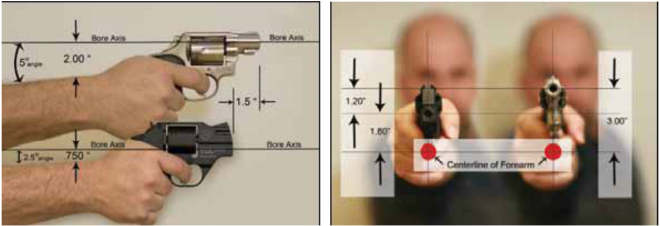
Visual representation of bore axis height from Chiappa Rhino manual. (Via Chiappa Firearms)
Low Bore Axis: Why
Having cleared what we are looking at, let’s now focus on the reasons behind this feature.
We have seen that the bore axis height is the distance between the bore center and the grip. Since along the bore center the recoil acts against the breech face, its force is offset from the grip axis by the above-mentioned distance. We have therefore a force and an arm perpendicular to it, the product of which generates a moment, more commonly known as torque. This torque is felt by the shooter as the muzzle flip.
With the force depending on the bullet mass and its acceleration, firearm designers can minimize torque, and therefore muzzle flip, by minimizing the length of the arm. Less muzzle flip means a faster realignment of the sights on target after each shot.
Hence the search for the lowest bore axis.
What About Recoil?
Frequently, handguns with very low bore axis are described as capable of decreasing the recoil, this, however, is not correct.
Only the muzzle flip is actually reduced and while this can be advantageous in most cases, with very high power rounds a direct linear push may be more uncomfortable than beneficial. This because the rotational forces resulting in the muzzle flip dissipate some of the recoil energy, which would otherwise be directly absorbed by hand and wrist if the recoil was directly in-line.
While the felt recoil depends on several factors, many of which are related to personal preferences (grip or stance, for example) of the shooters themselves, we can safely say that a low bore axis does not physically reduce recoil.
Target Pistols
The bore axis height has entered the mainstream “marketing buzzword dictionaries” around this decade, but this doesn’t mean that its advantages were unknown to firearm designers of the 20th century.
One field where the concept can be seen applied for decades is the one of Rapid Fire Pistol shooting competitions.
In Rapid Fire events the shooter must fire three series of five shot at a target placed at 25 meters (about 27 yards) distance, in an interval of time which is first 8 seconds, then 6 and finally 4. The rate of fire may seem low compared to practical shooting competitions levels, and the caliber is only .22 LR, so recoil and muzzle jump are limited. Minimizing any movement of the pistol however helps with follow up shots, especially considering that these are taken with one hand, unsupported, at 25 m.
Current target pistols used in these competitions, such as the Walther SSP, place the barrel definitely low with respect to the hand.

Walther SSP Pistol. (Via Carl Walther website)
However, when rules on overall size still allowed it, designers were able to experiment with more out-of-the-box solutions. One notable extreme being the Russian MTs 3-1 “Rekord” designed by Mikhail Margolin. This pistol employed a fairly standard slide and barrel, placed upside down in front of the grip, obtaining a barrel axis below the index finger of the firing hand. This configuration may have no muzzle flip or possibly a negative one, with the barrel moving downward at each shot.
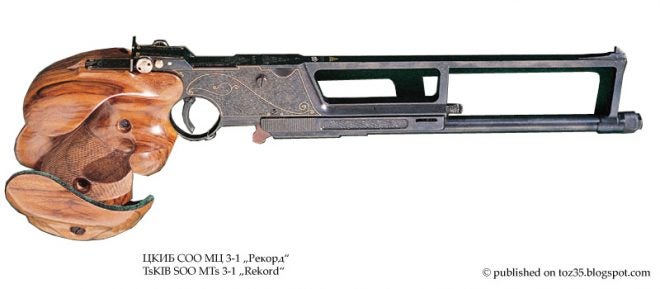
MTs3-1 “Rekord” low bore axis Rapid Fire pistol. (Via Toz35.blogspot.com)
Novel Designs
With target shooting in mind, stepping up with the caliber, another notable example of low barrel pistol from mid 20th Century is the amazing design of George Wilson (Patent Application US2975680A).
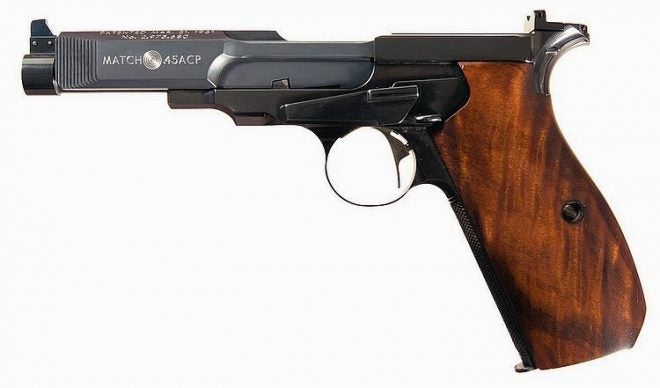
The gorgeous Wilson Pistol cal. .45 ACP. (Via Tony’s Bullseye Blog)
Far from ever being a commercial product, the Wilson Pistol definitely excels in offering a semi-automatic platform with magazine through the grip, full-size caliber (.45 ACP) and very low bore axis. More details can be seen in this great video from Forgotten Weapons.
In more recent years, an architecture similar to the Wilson’s has been employed, in a frankly less elegant package, by designer Dan Love to in his Revol Arms DL45 (Patent Application WO2014123628A2; Revol Arms website).
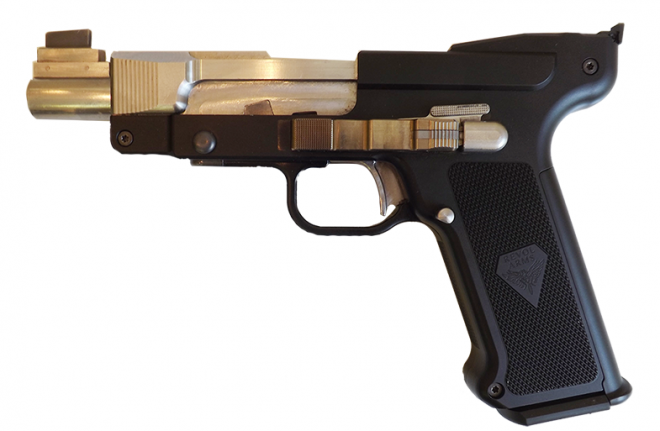
Revol Arms DL45, note the similarities with the Wilson pistol. This is, and looks like, a prototype. Hopefully, the manufacturer will be able to offer a more refined final product. (Via Revol Arms website)
Modern Semi-auto Pistols: 20th Century
One of the first modern semi-automatic pistols to offer a low barrel well before it became trendy, was the H&K P7, released in the late ‘70s.
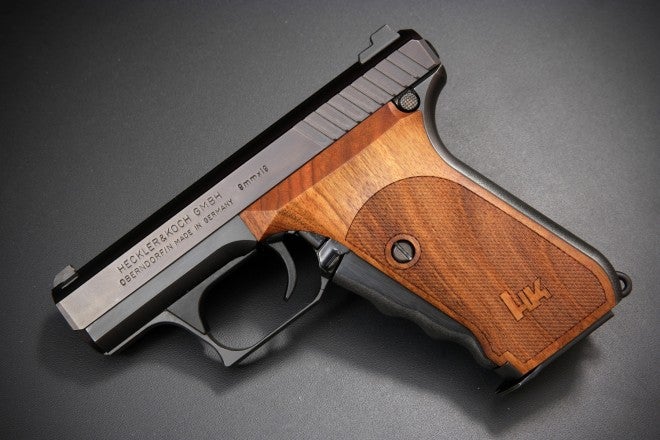
H&K P7 with wooden grips. (Picture courtesy of LifeSizePotato)
The advantages of this configuration were implied in its marketing material, however, the barrel height does not take the center stage.

A now-famous ad (dated 1988) on the H&K P7 trying to justify to the consumer the high cost of the handgun. (Via Caliban Blog)
More recently, in the ‘90s, Steyr offered the M9 family of pistols with a peculiar grip angle and shape which allow the hand to sit very close to the bore axis.

Steyr M9-A1 with its low profile slide and grip allowing high positioning of the hand. (Via Steyr website)
The same approach has been carried over in the latest generation of the pistol.
Modern Semi-auto Pistols: 21st Century
While the above examples are noteworthy, the pistol which can be seen as the trendsetter in the 21st century for low bore axis designs is the Russian-Italian Arsenal Strike One, now evolved into the Archon Firearms Type B. This model is truly the first that made a very low bore axis the centerpiece of its unique value proposition.
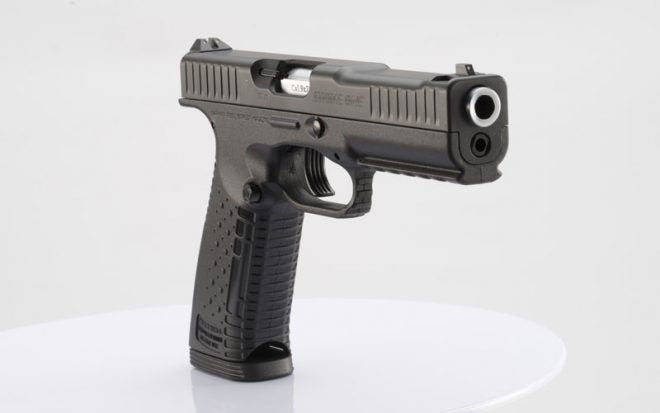
Arsenal Firearms Strike One. (Via Arsenal Firearm Italia)
The hype generated over this feature prompted some reviewers to verify its actual benefits. One interesting example is the below video from the YouTube channel GY6vids which offers an interesting comparison with a well known Austrian design.
As highlighted by our Vladimir Onokoy in his article on the origins of the Strike One, low bore axis is only one of the main ingredients in the “low muzzle flip” recipe, with slide mass being the other.
Another recent design sharing with the Strike One a very low bore axis, and a wide, possibly heavy slide, is the Czech Small Arms vz15.
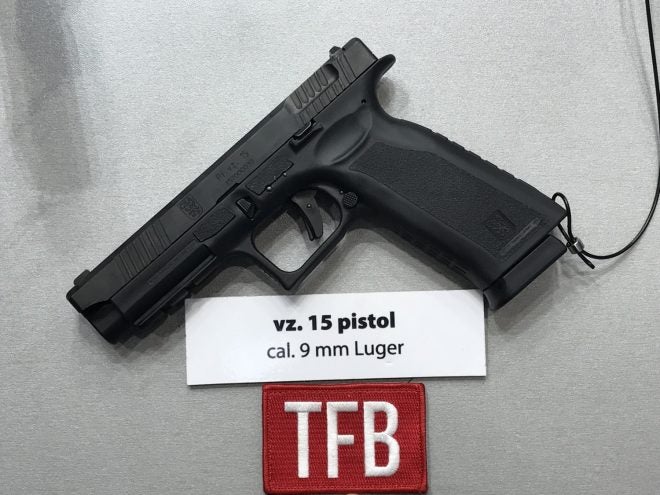
Czech Small Arms vz 15 pistol photographed at IWA 2018.
Beside the DL45 seen before, the only American attempt towards a lower bore axis seems to be the Hudson H9. A peculiar design with visually striking features which quickly set it in the “love it or hate it” category. Unfortunately the company has recently gone bankrupt, however, there are hopes for others to revive the project.

Hudson H9, with the characteristic bulge in the front of the trigger guard, housing the recoil spring and its guide. (Via Hudson Mfg. website)
The latest pistol to join low barrel club, possibly with the most unique features, is the Laugo Arms Alien.
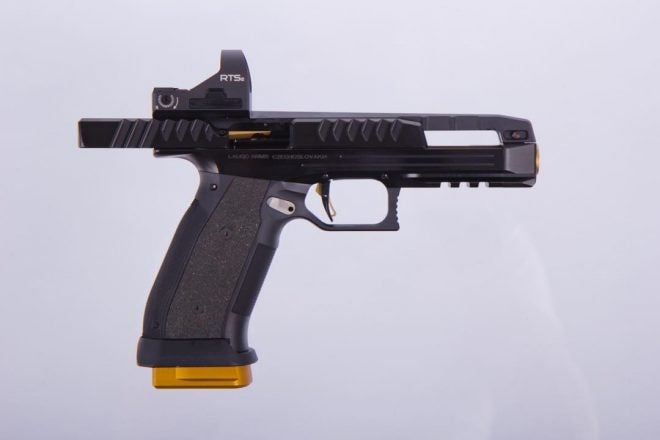
Laugo Arms Alien, note that the bore axis sits below the beavertail of the grip, placing the recoil force directly in the web of the hand. (Via Laugo Arms Instagram)
Seemingly developed with practical shooting competitions in mind, this handgun closes the circle started with the H&K P7, as it offers an extremely low bore axis by flipping upside down the operating system (gas retarded blow-back) of the German pistol. Also, the hammer sits above the bore axis, and the slide seems to be very light.
While this product is largely untested, it seems capable of setting a very high bar for manufacturers willing to offer the pistol with the lowest muzzle rise.
Conclusions
It is clear that the concept of the low bore axis is now well known in the market and, while actively sought mostly by smaller manufacturers willing to differentiate, it has also influenced the design of bigger names, such as the Beretta Group (see Beretta APX and Stoeger STR 9).
Others, most notably SIG Sauer, seem more keen on keeping their standard architecture, possibly believing that the advantages given by a low barrel are only marginal and not worth a complete redesign.
Time, and the market, will tell us if this will just be a fad or the feature will become increasingly more widespread.
 Your Privacy Choices
Your Privacy Choices
